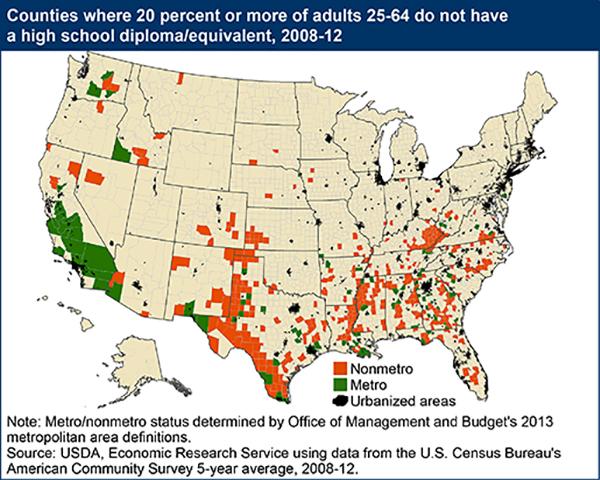The Economic Research Service (ERS), a key branch of the U.S. Department of Agriculture, continues to shed light on the critical intersections between employment and education in rural America. Their latest analyses delve into how educational opportunities—or the lack thereof—directly influence employment prospects and economic vitality in rural communities. As these areas face unique challenges including limited access to quality schooling and workforce development, ERS research offers vital insights for policymakers aiming to bridge educational gaps and promote sustainable economic growth beyond urban centers. This article explores the latest findings from the ERS on rural education and its profound impact on employment patterns across the nation’s countryside.
Challenges Facing Rural Education in Employment and Economic Development
The persistent gap in educational resources between rural and urban areas considerably hinders economic growth and employment opportunities in less populated regions. Limited access to quality schools, technology, and qualified educators creates a cycle of educational disadvantage that directly affects workforce readiness. Students in rural areas often face challenges such as outdated curriculum materials, insufficient extracurricular programs, and longer travel distances to attend schools, all contributing to lower high school graduation rates and limited post-secondary educational attainment.
Key obstacles impacting economic development linked to rural education include:
- Inadequate infrastructure for online learning and digital literacy
- Fewer vocational training options aligned with local industry needs
- Difficulty attracting and retaining skilled teachers in remote areas
- Limited career counseling and job placement services
| Issue | Impact on Employment | Economic Implication |
|---|---|---|
| Teacher Shortages | Reduced skill development | Lower local productivity |
| Limited Tech Access | Digital divide in workforce | Missed innovation opportunities |
| Transportation Barriers | Higher dropout rates | Smaller labor pool |
Analyzing the Impact of Educational Attainment on Rural Workforce Opportunities
Educational attainment plays a pivotal role in shaping the employment landscape in rural areas. Workers with higher levels of education often access a broader range of job opportunities, including skilled trades, healthcare, technology, and administrative roles. Conversely, limited educational resources and lower attainment levels in these communities reinforce cycles of underemployment and economic stagnation. This disparity underscores the importance of investment in rural education infrastructure and vocational training programs tailored to the needs of local industries.
Key factors influencing rural workforce opportunities include:
- Access to specialized training and remote learning options
- Availability of local employers requiring advanced skills
- Transportation and connectivity impacting commuting possibilities
| Education Level | Employment Rate (%) | Median Income ($) |
|---|---|---|
| Less than High School | 55 | 28,000 |
| High School Graduate | 68 | 35,000 |
| Associate Degree | 75 | 42,000 |
| Bachelor’s Degree or Higher | 82 | 53,000 |
The table above illustrates a clear trend: as educational attainment increases, so do employment rates and median income levels in rural regions. This correlation suggests that enhancing educational opportunities can serve as a catalyst for economic growth and workforce diversification beyond traditional farming and manual labor sectors.
Policy Recommendations to Strengthen Rural Education and Boost Local Economies
Targeted investments in rural education infrastructure can create a foundation for long-term economic growth. Prioritizing enhanced broadband access and modernized classroom facilities supports digital literacy and innovative teaching methods, which are crucial for today’s job market. In addition, developing partnerships between local businesses and educational institutions fosters vocational training programs, aligning curriculum with real-world skills needed in emerging industries like renewable energy and agritech. Policy measures should also include:
- Increased funding for STEM education tailored to rural economies
- Incentives for teachers to serve and stay in rural communities
- Support for distance learning to expand educational reach
Moreover, enhancing career counseling and job placement services within rural schools can directly link education to employment. This approach not only reduces local unemployment rates but encourages youth retention, preventing brain drain to urban centers. To illustrate, the table below highlights the comparative benefits of integrated rural education programs based on recent economic research:
| Program Type | Employment Rate Increase | Local Business Growth (%) |
|---|---|---|
| Vocational Training Partnerships | 12% | 8% |
| STEM-Focused Curriculum | 15% | 10% |
| Distance Learning Expansion | 9% | 5% |
Future Directions for Research on Education and Employment in Rural Communities
Emerging research avenues emphasize the integration of technology and digital infrastructure as pivotal to transforming education and employment outcomes in rural communities. Studies should prioritize how broadband access and digital literacy programs can bridge geographic disparities, fostering greater participation in remote learning and telework opportunities. Additionally, the role of local cultural context and community-led initiatives in shaping educational pathways deserves focused attention to ensure policies are not only inclusive but also reflective of unique rural identities.
Another critical area for future research involves the evaluation of sustainable economic development models tailored to rural labor markets. This includes examining the impact of vocational training aligned with local industry needs and the potential of entrepreneurship support networks to stimulate job creation. Researchers are called to deploy mixed-methods approaches that combine quantitative labor metrics with qualitative insights from rural residents to capture the nuanced interplay between education systems and evolving economic structures.
- Digital Equity: Assessing the effects of improved internet connectivity on rural education access.
- Community Engagement: Understanding participatory approaches in curriculum design and employment programs.
- Workforce Alignment: Mapping training programs to regional economic sectors for targeted skill development.
- Entrepreneurship: Investigating support mechanisms for small business growth and innovation in rural settings.
Closing Remarks
As rural communities continue to navigate the challenges of economic shifts and population changes, the role of education remains a critical factor in shaping future employment opportunities. Insights from the Economic Research Service underscore the need for targeted investments and policies that address educational disparities in these areas. Sustained efforts to enhance rural education promise not only to improve individual outcomes but also to bolster local economies, ensuring that rural America remains a vital and resilient part of the nation’s workforce.




